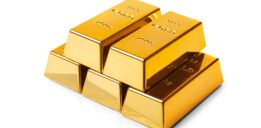Don’t Ignore Central Banks When Trying to Figure Out Where Gold Prices Are Headed Next
Central banks love gold. They want to buy more, and the price doesn’t matter to them. Long-term investors make a note of this: central banks could send gold prices soaring.
You see, actions speak louder than words, and the central banks’ actions are clearly in favor of gold.
For a while, central banks thought that the U.S. dollar was the only thing worth holding in foreign reserves. After the financial crisis 2008–2009, when the dollar faced a rigorous sell-off, they understood very clearly that the greenback may not be as safe as it was once assumed.
Remember, central banks are like the wealth managers of countries. The last thing they would want to do is own something that’s volatile.
Why gold? Because the yellow precious metal is one of the best hedges against volatility in reserves.
Central banks have been buyers of gold bullion for their reserves since the financial crisis.
In Q2 2018, Central Banks Buy for the 30th Time
In the second quarter of 2018, central banks purchased 89.4 tonnes of gold. In the first half of 2018, they purchased 193.3 tonnes of the yellow precious metal. This was eight percent higher than in the same period a year ago. (Source: “Gold Demand Trends Q2 2018,” World Gold Council, August 2, 2018.)
Looking from an even broader perspective, the second quarter of 2018 marked the 30th consecutive quarter when central banks were net buyers of gold.
$11.6 Trillion Worth of Assets May Need Some Hedge
Here’s the thing, central banks may not be done buying gold just yet. They may need a lot more of it.
Understand this: central banks around the world have massive amounts of foreign reserves. According to the International Monetary Fund (IMF), at the end of the first quarter of 2018, total foreign reserves stood at $11.6 trillion. (Source: “Currency Composition Of Official Foreign Exchange Reserves,” International Monetary Fund, last accessed August 7, 2018.)
The majority of these reserves are denominated in the U.S. dollar—close to $6.5 trillion worth.
So, it’s possible that central banks may be looking to diversify a little. If we assume that they just allocate 10% of their reserves toward gold, that means they would need to buy almost $1.2 trillion worth of gold.
You know what? Halve that amount and it would still be almost $600.0 billion.
Know this: the gold market is small when compared to the bond market or the stock market. An inflow of about $600.0 billion could create a massive impact on the price of gold.
Gold Prices Could Go Much Higher
Now, one could ask: “How do I know when central banks will buy gold?”
Dear reader, central banks have a lot of buying power. I can’t stress enough that their actions are speaking louder than their words.
Don’t expect them to announce when they will be buying gold. If they did that, it could move the price of gold up a lot. Speculators would front-run them and gold prices would soar before the central banks even had a chance to buy.
For that reason, the last thing the banks would want to do is announce their purchases beforehand. They will only report after they have bought.
So, which central banks will be buying gold? It won’t be the banks from developed economies, so don’t expect the U.S. Federal Reserve to buy. The Fed already has a lot of gold.
I am paying very close attention to central banks from emerging economies. They don’t have much gold, and it seems like their appetite for the precious metal is immense.
With all this in mind, I believe that central banks are making a very strong case for much higher gold prices. I continue to see the yellow precious metal as an undervalued play.






